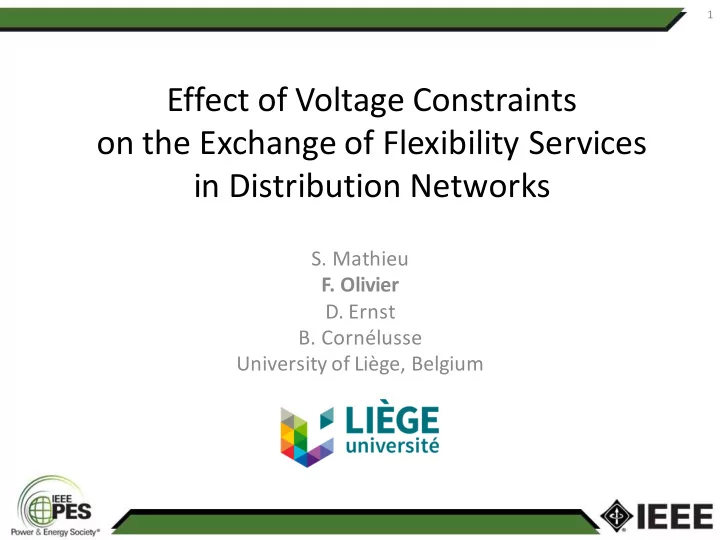

1 Effect of Voltage Constraints on the Exchange of Flexibility Services in Distribution Networks S. Mathieu F. Olivier D. Ernst B. Cornélusse University of Liège, Belgium
2 Introduction • European energy sector and regulation • Gredor project – Collaborative project with actors of Belgian electricity sector (TSO, 2 DSO, producersand retailers) – Think about new ways to operate the distribution sytems of the future, from investment planning to real-time control
3 Unbundling in Europe Energy Sector • A DSO cannot – directly control the production means connected to its network – be a retailer • European directive (Article 26 of the directive 2009/72/EC)
4 Fit and forget Vs.Transactive energy • Fit and forget – Network planning based on critical scenarios – Operational margins always ensured without control over the loads or the generation sources – May lead to prohibitive reinforcement costs • Transactive energy (active network management) – Network planning using the flexibility services proviced by generation sources, loads and storage
5 Flexibilityservices covered by Interaction models Framework defining the interactions between the actors
6 Access bounds and access contracts Requested range Safe range Power 0 Restricted access range Dynamic access range (varying in time) Unrestricted access range
7 Flow of interactions Bullets: optimizationproblems • Arrows: flow of information • Grid users
8 A day in the life of a grid user 1. Sends its baseline to the TSO and DSO 2. Obtains flexibility needs of the flexibility service users 3. Proposes flexibility offers 4. Receives activation requests 5. Decides the final realizations
9 Studied interaction models Model 0 Model 1 Model 2 Access type Restricted Dynamic Unrestricted Financial None None Full compensation Full financial compensation: - DSO pays a reservation and activation cost - DSO pays for the resulting imbalance cost caused by the activation of flexibilityservices
10 DSIMA • Distribution System Interaction Model Analysis • Open source test bed available at http://www.montefiore.ulg.ac.be/~dsima/ • Implemented in Python • Every agent modelled individually with mixed-integer linear programs • Optimization written in ZIMPL and optimized using SCIP
11 DSIMA • HTML interface to visualize the results
12 Network flow Vs. Linear power flow • Network flow – Takes into consideration line capacity constraints • Linear power flow – Takes into consideration line capacity and voltage constraints, but neglect losses – S. Bolognani and S. Zampieri, “On the existence and linear approximation of the power flow solution in power distribution networks,” IEEE Trans. on Power Systems , no. 99, 2015 – Bounded approximation error
13 Linearizing constraints • Maximum power constraints • Minium and maximum voltages constraints Conservative error of 3.5% Conservative error of 1.92% with 4 cutting points with a voltage angle of 15°
14 Test system • Test system based on a real MV distribution network from ORES (Belgium DSO) • 328 MV buses
15 Results – Welfare Sum of the benefits and costs of each actor with their sign, and a protection cost (penalty for under and over-voltages, cost of shedding)
16 Results
17 Conclusion • With voltage constraints – Weaknesses in model 0 and 2 (restricted and unrestricted) – Model 0 is too restrictive – Model 2 is too permissive • Motivates the use of model 1 (dynamic) as a solution in-between – All problems are not solved using flexibility – Some reinforcement necessary – Can be identified with the simulations
18
19 Results breakdown
20 Protection cost and quality of service • Shedding of MV buses – Value of Lost Load (VOLL) – VOLL: 1000 €/MWh • Under- and Over-voltages – Base power: Sb: 100 MVA – Base voltage: Vb: 10 kV – VOLL*Sb/Vb = 10 000 €/kV – ± 5% voltage variations
Recommend
More recommend